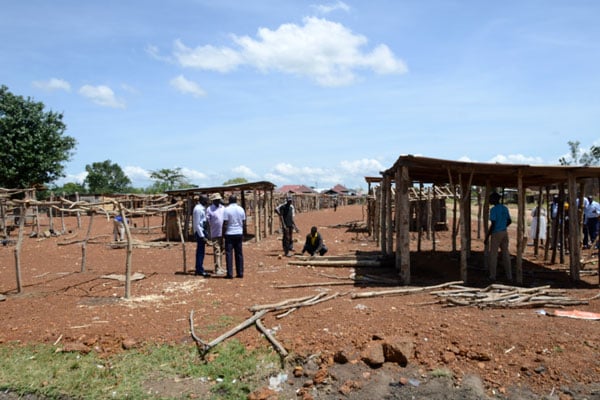Government power projects face dark future as Energy Fund dries up

Works underway. A chinese engineer shows a view of the Karuma Hydro Power Dam to an MP and a Police officer recently. Photo By Julius Ocungi.
What you need to know:
Call for money. Energy ministry has asked their Finance counterparts to replenish the depleted Energy Fund but the Budget office says the fund is not catered for in the 2017/2018 budget, writes Nelson Wesonga
The Energy Fund, established in 2008 to ring–fence money to finance electricity transmission and generation projects, is running on empty.
In total, Shs1.3 trillion has been drawn down from the Fund in the course of the last four fiscal years.
Part of that money was used for counterpart funding for the Karuma and Isimba hydropower projects and payment of insurance and loan management fees relating to the two projects.
It also paid for consultancy services that were carried out around the two power projects and a series of Resettlement Action Plan (RAP) activities.
The money was also used to meet some of the costs that the implementing agencies, namely the Uganda Electricity Generation Company Ltd (UEGCL), and the Uganda Electricity Transmission Company Limited (UETCL’s) incurred during the course of work on the two projects.
Lastly, the money was used to meet the costs of statutory activities, including undertaking environment impact assessment studies associated with the Karuma and Isimba projects and for the construction of an electricity transmission line to carry electricity from the Kaliro Sugar and Allied Industries Ltd co-generation power plants to the national electricity grid.
However, Daily Monitor could not establish how much money has gone into the Fund over the years.
But one account indicates that government had been depositing an equivalent of $70 per year. That would mean that the total injected had risen to $560 million over an eight-year period.
Although the figure could not be independently verified, Daily Monitor was able to establish that Shs1.342 trillion had been drawn from the Fund between the Financial Years 2013/2014 and 2016/2017.
According to a schedule provided by the Deputy Secretary to the Treasury, Mr Patrick Ocailap, Shs8,746,698,000 was withdrawn in the Financial Year 2013/2014 to pay for insurance and [loan] management fees.
Another Shs879,999,999,000, some of which came from the Petroleum Fund, was withdrawn in the Financial Year 2014/2015 to cater for counterpart funding for the Karuma and Isimba hydropower projects.
An additional Shs71,847,641,000 was in the same financial year used to pay insurance and loan management fees.
Another Shs17,943,891,000 was withdrawn to pay for consultancy services and resettlement action plan (RAP) activities. And more Shs10,116,661,000 was withdrawn and allocated to meet the costs of implementing agencies, UEGCL and UETCL.
Also in the same Financial Year 2014/2015, another Shs8,918,418,000 was spent on statutory costs associated with Karuma and Isimba while another Shs3,057,846,000 went towards the evacuation of 6.9 megawatts from Kaliro Sugar and Allied Industries Ltd co-generation plant to the main grid.
In the Financial Year 2015/2016, Shs239,089,697,000 was drawn down to settle insurance and management fees and Shs12,997,216,000 was paid for consultancy and resettlement action plan (RAP) activities.
Another Shs7,970,048,000 catered for the Karuma and Isimba’s statutory costs – such as the National Environmental Management Authority fees.
This fiscal year (2016/2017), Shs12,997,216,000 was spent on consultancy services and resettlement action plan (RAP) activities while Shs68,746,581,000 went towards the implementation agencies costs.
Word that the Fund was depleted had been doing the rounds in the electricity sector for months.
Ms Irene Muloni, the Energy minister, would later tell the media during a press conference in Kampala that the Fund should be “capitalised”.
when asked how much of the Fund was left, she curtly said: “I am not in charge of the Energy Fund. It is under the Minister of Finance. Ask the Minister of Finance to tell you.”
On his part, the Minister of Finance and Economic Planning, Mr Matia Kasaija, says the Fund “has no money,” adding that it is a technical issue which would best be answered by the technocrats since ministers deal with only policy.
President Museveni’s decision to initiate the Energy Fund was informed by the challenges government faced in the electricity sector in the early 2000s.
At the time, power generation capacity was sometimes as low as 150 megawatts on account of low water levels. For instance, Lake Victoria’s water level then had dropped by 1.5 metres.
This was attributable to a long dry spell blamed on climate change inducing factors – occasioned by human activities and the construction of another dam parallel to the Owen Falls Dam.
Meanwhile, demand was increasing, and this meant power had to be rationed, with many cottage industries, both medium and large manufacturing concerns and households going for hours without electricity.
Those that could afford invested in generators, which, however, had to be fuelled with either diesel or petrol.
Efforts to address the power generation constraints were later stalled when Parliament initially refused to approve a project to develop a hydropower plant at Bujagali. The House then had reservations about the generation tariff as well as the environmental impact of the plant.
However, Parliament softened their stance.
The worst blow though was delivered by World Bank, which in 2002 suspended support for the project.
This was after a United States (US) Department of Justice investigation found that a Ugandan Cabinet minister had been compromised to grant the contractor some concessions.
The USA had an interest in the Bujagali project because AES, a company that could be traced to the US, was involved in the project.
The World Bank’s action was followed by the withdraw from the Bujagali project by the contractors – Veidekke (the main contractor) and Skanska (the electrical contractor).
Although the government of Uganda later sought bids for the Bujagali project and got takers, President Museveni picked one lesson: Uganda needs its own pool money for energy infrastructure.
It was against this backdrop that the then minister of Finance, Mr Ezra Suruma, through a Statutory Instrument, established the Energy Fund.
The purpose of the Fund was to assist in the mobilisation of financial resources for the planning as well as the development of electricity generation and transmission projects.
It was also to address the electricity needs of Uganda by developing and exploiting the existing resources and exploring the use of other resources.
With grants from the government, loans obtained by the government, and grants from other sources the minister of Finance would approve, would then finance the identified power projects.
According to the Statutory Instrument, to withdraw money from the Fund, the Finance minister shall, after consultation with the minister for Energy, and the accounting officer, withdraw monies from the Fund.
The withdrawals would be on condition that the project for which the money is to be withdrawn is one of those that should be funded from the Fund.
The Finance minister would also clear a draw down if it is in the public interest that the funds should be provided from the Fund for financing the project identified.
The Auditor General’s 2016 annual report on statutory bodies says contract ledgers, which record and monitor cumulative payments on Karuma and Isimba projects, are not maintained –making it difficult to track the cumulative investments in the projects.
Information on how much could have been deposited into the Fund, which we do not have, would have given a fuller picture.
The Office of the Auditor General has in the past questioned the method of running the Fund.
The report notes there was lack of operational guidelines for the Fund as well as unauthorised expenditures out of the Fund and also direct payments made out of the Fund.
The report says the lack of operational guidelines for the Fund’s activities and financial reporting meant there was risk of uncoordinated operation of the Fund, resulting in sub-optimal decision-making.
On unauthorised expenditure, the report says Shs10.4 billion was paid out of the Fund without evidence of requisite authorisation by the Finance minister.
This was in contravention of the Public Finance and Accountability Act, 2003.
The report said the payment without authority exposes the money in the Fund to risks of misappropriation, which would undermine the objectives for which the Fund was established.
When the Office of the Auditor General reportedly asked the management of the Fund why there was unauthorised expenditure out of the Fund, the manager said there were some running contracts whose obligations had to be met using money from the Fund.
The management reportedly added they anticipated the Finance minister would later authorise the use of the money.
When it came to direct payments from the Fund, the report said Shs11.2 billion was paid out directly from the Fund to Energy Infra tech Ltd, a company that was and still is providing consultancy services to the Energy ministry on the supervision of the construction of the Karuma hydropower project.
It is also reported that a year earlier, Shs7 billion had been similarly paid out of the fund.
The practice of making direct payments from the Energy Fund account turns it into an ordinary operational account, the report said.
In response to the auditor’s query, the management of the Fund reportedly said they had requested for the opening of an operational account, which was pending approval.
Mr Ocailap said money drawn down on the Energy Fund follows the normal appropriation since the Energy Fund is like any other Consolidated Fund account.
“Drawing money from that does not require separate procedures; it requires appropriation by Parliament and through a warrant by the Accountant General,” Mr Ocailap said.
With many Finance officials confirming there is no money in the Fund, there is no doubt that some of the projects that had been lined up will be affected.
One of the specific projects that were to be financed by the Fund was the resettlement action plan for the Lira–Gulu–Agago transmission line.
According to information on UETCL’s Website, the Government had by Tuesday, May 30 not released to UETCL funds for the resettlement action plan.
Funding for the line is also not reflected in the budget estimates for the Financial Year 2017/2018.
The Fund is also supposed to cater for the RAP for the 132kv transmission line from Kabulasoke to Hoima.
The future of electricity generation projects such as Oriang and Ayago, which had been planned to take off, now hangs in the balance because no money has been planned for injection into the Fund in the Financial Year 2017/2018, but there is a promise that it will be made available in future.
“We will replenish it, that is for sure. If it is not replenished next year, then we can only do it in the one after that,” Minister Kasaija said.
The country waits to see what impact the situation will have on the energy sector.




